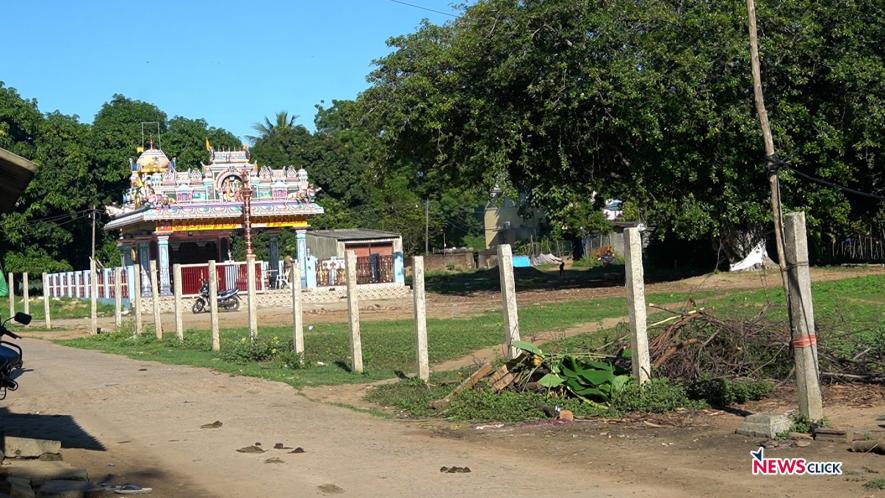Untouchability Walls Razed in 2 Tamil Nadu Villages, Fears of Revenge by Upper Castes

The demolished ‘untouchability wall’ in Thokammur. It was built close to the houses of the Adi Dravidars SC community.
The demolition of two ‘untouchability walls’ in Tamil Nadu’s Tiruvallur district, around 50 km from Chennai, within one month by the administration has triggered fears of retaliation by dominant communities among the marginalised in two villages.
The walls, built to restrict the Kattunayakan Scheduled Tribe (ST) in Thatchur and the Adi Dravidar Scheduled Caste (SC) in Thokammur village, were demolished on September 25 and October 3, respectively.
The villagers, particularly from Thokammur, continue to face threats from the dominant caste and have requested government intervention for their safety. A barbed wire around the Draupathi Amman temple to restrict the access of the SC has not been removed. The villagers have demanded the removal of the fence.
The Tamil Nadu Untouchability Eradication Front (TNUEF) and the Tamil Nadu Tribals Association (TNTA) have led prolonged struggles against such walls by holding protests and public meetings and demanding their demolition.
EIGHT-MONTH STRUGGLE SUCCESSFUL
The presence of the wall, constructed in 2016 in Thokammur, was brought to the notice of TNUEF eight months ago and it immediately demanded its demolition.
“The wall, built under the guise of protecting the Draupathi Amman temple by upper-caste people, was 30 feet away from the houses of the Adi Dravidars. It took a while for the community to understand the true intentions behind constructing the wall,” N Kanniappan, Tiruvallur district secretary, TNUEF, told Newsclick.
The dominant and numerically strong Reddiyar community had constructed the wall, which also caused water stagnation in the area where the Adi Dravidars reside.
TNUEF and the Communist Party of India (Marxist) [CPI(M)] took up the discrimination with the administration on February 26 and a protest was held on May 27 demanding immediate action.
“We had announced plans to demolish the wall on September 29 after which the district administration swung into action. After the sustained struggle of the CPI(M) and TNUEF, the wall was demolished on October 3,” Kanniappan said.

The demolished wall with the Draupathi Amman temple in the background.
FENCE STILL STANDS
The fence around the temple restricts the SC community’s access to the village office, panchayat office and school.
“The upper-caste people are unhappy with our children going to school and playing in the area around the temple. The fence prevents us from reaching government offices,” Radhika, a resident of the village, told Newsclick.

The fence around the temple prevents the members of the SC community from using the road and the playground.
“The fence should also be removed since it is on land owned by Adheenam lands and not by any individuals. The fence is illegal,” Kanniappan said.
FEAR AND DISCRIMINATION
The villagers are scared as the dominant community continues to verbally abuse and threaten them. The district administration has deployed a few policemen for now.
“We are being threatened by the men from the other side. They are hurling abuses, threatening us and claiming that the police have been deployed only for a short time, said Radhika.
TNUEF has demanded that the district administration intervene and ensure protection of the marginalsied community. “The water supply to their settlement has been cut off as an act of revenge. The administration’s immediate intervention is essential to prevent any untoward incident,” Kanniappan said.
The residents shared incidents of discrimination while working under the Mahatma Gandhi National Rural Employment Guarantee Act (MNREGA).
“There was no discrimination until a few years ago. All of us worked together and rested under the trees around the temple during work. Later, we were sent to unsafe places around the village where snakes are present,” Radhika alleged.
The SC community once faced the worst form of untouchability with its members not allowed to wear slippers in areas occupied by upper-caste people.
ANOTHER WALL DEMOLISHED IN VAZHAVANTHAKOTTAI
A few kilometres away, in Valavanthankottai village, a wall separated the Kattunayakan community from the Vanniyars, who belong to the Most Backward Classes (MBC). After TNTA demanded its demolition, the wall was demolished on September 25, 2011.

The demolished wall, which was close to the huts of the Kattunayakan community in in Valavanthankottai village.
“The wall was built by a real estate proprietor to hide the small huts from the plots he had put up for sale. They individual tried to remove these people. TNTA and the CPI(M) prevented it and ensured their safety,” Kanniappan said.
The residents still don’t have access to proper drinking water, toilets and roads. TNTA has demanded basic amenities at the earliest.
Images: R Prakash.
Get the latest reports & analysis with people's perspective on Protests, movements & deep analytical videos, discussions of the current affairs in your Telegram app. Subscribe to NewsClick's Telegram channel & get Real-Time updates on stories, as they get published on our website.
























